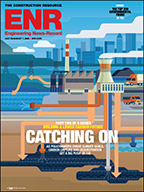The Top 200 Environmental Firms managed to grow revenue in 2011 despite economic uncertainties around the world and tightening infrastructure budgets in the public sector, traditionally a mainstay for this group. But where one window closed, a door opened for providers of environmental services on the 2012 list. Overall revenue was up 5%, to $54.1 billion, a slower rise than the 6.2% of the previous year but buoyed by increases in non-U.S. work and private-sector activity, which each exceeded 20%.
The domestic market still made up a major share of firms' revenue base, but completed projects and changing public-sector spending patterns made revenue growth anemic, up only 0.7% from the previous year's total, to $41.6 billion. Firms reported 5.2% and 6.1% drops, respectively, in revenue derived from federal and state owners, while the construction and remediation category total fell 7.1% and wastewater was off 3%. "My feeling is that many contractors who attempted to break into or increase their environmental construction work fared poorly," says Jim Voltz, president of American Contracting and Environmental Services. As a result, he anticipates "less competition and less price cutting in 2012."
But the nearly 23% hike in Top 200 firms' private- sector-generated revenue and the 25% rise in spending beyond U.S. borders managed to fill coffers for listed companies. The Top 200 also reported that revenue in environmentally oriented consulting and studies rose more than 15%, while volume in the environmental management sector increased nearly 6%. Noting ups and downs in its various market sectors, Chris Vincze, CEO of TRC Cos. Inc., says, "Across our total platform, environment work was good but not great."
Adds Michael J. Graham, principal vice president of Bechtel, and manager of U.S. environmental work, "It's an interesting time with the budget challenges that the country faces. We're seeing a shift in maturity cleanup work. Fiscal 2012 was challenged with the end of the American Recovery and Reinvestment Act. Everyone has worked their way through that bubble."
Even so, list leader CH2M Hill Cos. crossed the $4-billion threshold in environment-services revenue for the first time, while MWH Global moved into the list's Top 10, displacing Kiewit Corp. Joining the Top 200 for the first time, among 19 other firms not ranked last year, is Clean Harbors Inc. The waste services and emergency cleanup company reported more than $1.1 billion in revenue for 2011 (see story, p. 59).
Another new name on the list is Aegion Corp., which last year became the new parent of water-wastewater pipeline contractor Insituform Technologies and several market-related firms. The firm noted last month improved operating profit for its North American environmental-infrastructure segment.
The water-wastewater sector also appeared to reward traditional builders such as Pepper Construction, which rose to No. 67 in the rankings based on wastewater-related revenue, and McCarthy Holdings Inc., which debuted at No. 62. But revenue stayed flat for other list participants in this sector.
PCL's Water Infrastructure Group recently won a $192-million wastewater-treatment-plant expansion and rehab project in Riverside, Calif., that, when complete in late 2015, will be the largest membrane bio-reactor retrofit project undertaken in the U.S., according to the firm. Luis Ventoza, president of PCL Infrastructure Management, is optimistic the sector will benefit from "growing interest in private-public partnerships and legislative measures being enacted in states to facilitate this delivery method and other alternative delivery methods."
Top 200 firms also working in sectors such as transportation found new environmental revenue streams. Parsons Brinckerhoff cites "sustainable" transportation planning and programming as a major market driver but says the delay in enacting federal funding limited work in environmental research and analysis for planned projects.
Ileana Ivanciu, vice president for environmental services at Dewberry, says the firm has helped the New Jersey Dept. of Transportation and the New Jersey Turnpike Authority use sustainable remediation approaches at project cleanup sites. "We have designed and implemented bioremediation programs that eliminate the need for energy-guzzling pump-and-treat remediation systems," she says. Ivanciu adds that early-onset environmental work has led to larger project roles. Dewberry's work as a subconsultant to prepare an environmental impact statement for a highway widening in New Jersey also led to a larger role as design program manager on the project, overseeing five consultants.





Post a comment to this article
Report Abusive Comment